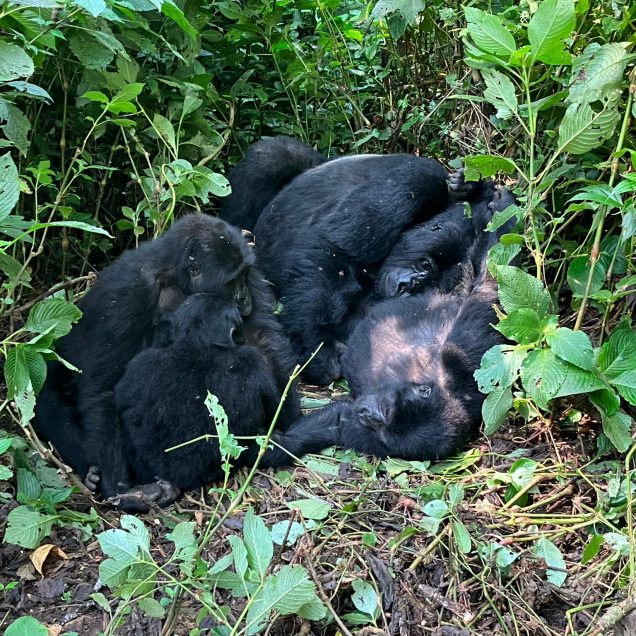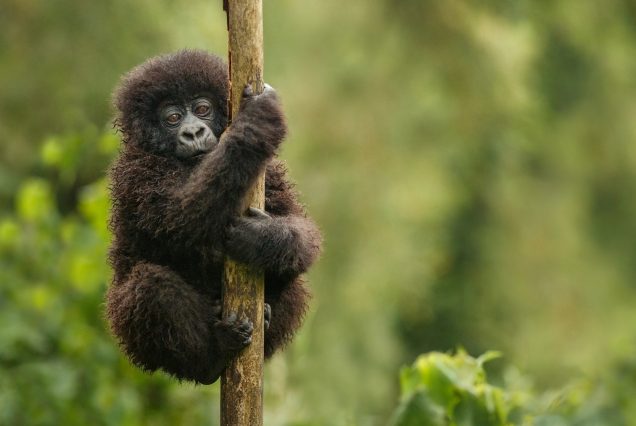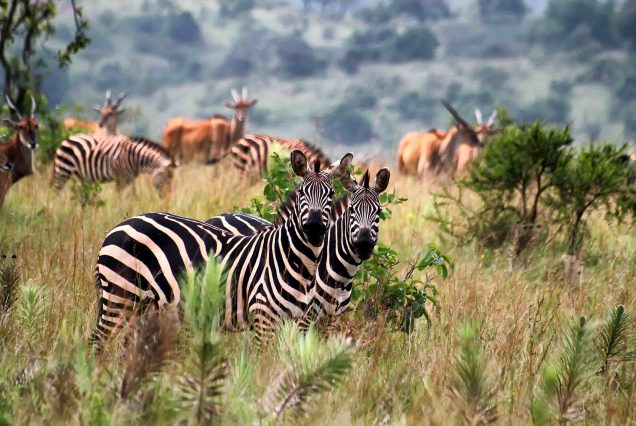Volcanoes National Park in the northwest of Rwanda, the ‘Land of a thousand hills’ is a breathtaking tour site renowned for its population of the critically endangered mountain gorillas. With a total land size of about 160 square kilometers, this ecosystem is found within the Virunga Massif in the Albertine rift region. Volcanoes is comprised of 5 out of the 8 volcanoes in the Virunga Mountains, including Bisoke, Karisimbi, Muhabura, Gahinga, and Sabinyo. The park has a variety of habitats including montane forest, bamboo forest, undulating hills, swamps and marshes. Besides the mountain gorillas wildlife include golden monkeys, elephants, birds like the Rwenzori turaco and also numerous plant species.
Volcanoes National Park is also among the first national parks to be established in the African continent because it was gazetted in 1925 to protect the mountain gorillas. However, the site underwent numerous dynamics including encroachment that decreased its size as well as expansion that increased it. Significantly, the disastrous 1994 Rwandan Genocide affected tourism here until the park was reopened in 1999. Since then, the government has implemented various strategies to ensure that it is well managed and the wildlife are conserved. Currently, the Rwanda government has plans to increase the park size. Visitors from all over the world come to Volcanoes National Park each year to enjoy the numerous activities offered.
What to do at Volcanoes National Park
There are plenty of tour activities to experience in this renowned national park, and they include the following,
Gorilla trekking tour
With over 300 individual mountain gorillas and at least 10 habituated gorilla families in the lush forests of Volcanoes National Park, a choice to do a gorilla trek is irresistible. An intimate encounter with these gentle giants involves a guided trek through the dense forest to locate a designated habituated gorilla family. You will encounter and spend an hour watching and taking photos of these adorable creatures in their natural habitat. The gorilla trek could last somewhere between 3 to 6 hours depending on your physical fitness and the location of the habituated gorilla family. You need to be at least 15 years old, with a gorilla permit and in good health to enjoy this highly desired adventure.
Birdwatching tour
In the Virunga massif, there are plenty of endangered and endemic bird species that number up to over 250, including over 20 Albertine endemics. Volcanoes National Park is also an Important Bird Area; and a guided birding tour here offers birders and ornithologist a perfect getaway. In this birding hotspot, you can watch the colorful avifauna including the Grauer’s swamp warbler, Rwenzori batis, Rwenzori turaco, Shelley’s crimson wing, mountain masked apalis, regal sunbird, strange weaver, Kivu ground thrush, handsome francolin, Rwenzori double-collared sunbird, collared apalis, Rwenzori nightjar and Archer’s ground robin.
Golden monkey trekking tour
With 2 habituated golden monkey troops available to trek in Volcanoes National Park, you will have a captivating adventure in one of the few sites in Africa to experience this. This guided tour involves locating a designated troop of these old-world monkeys swinging within the graceful bamboo trees. Upon meeting them, you will spend an hour watching as they forage and interact with each other. Photographs are allowed so long as you follow instructions by the ranger guide who will accompany you. The minimum age for a golden monkey trek is 12 and just like a gorilla trek, you must have a permit as well as ensure that you are free from illnesses that might affect your journey.
Cultural tour
Experience the rich tapestry of Rwandan heritage as you encounter the indigenous people and their way of life. Just adjacent to Volcanoes National Park are the Batwa Pygmies, which is a community of former dwellers and custodians of the forest. You can also have an encounter with the Rwandese at the Iby’iwacu Cultural Village. This is a popular cultural site to gain more insight into the country’s anthropological aspects. In addition to the Batwa, you will encounter the Tutsi and Hutu people for an intimate interaction. This tour will ensure that you appreciate their history, beliefs, customs and others through folk tales, music and drama. You will also learn about their food, medicine, architecture, hunting techniques and craftsmanship.
Hiking tours
Volcanoes National Park offers a variety of hiking adventures to various scenic sites. These are guided adventures to sites including Dian Fossey Tomb, Mount. Bisoke and Mount. Karisimbi among others. These experiences also offer opportunities to witness a variety of bird, mammal and primate species. These include the mountain gorillas, golden monkeys, elephants, buffalos, and bush pigs among others. While hiking the volcanoes, you have an opportunity of observing crater lakes, alpine vegetation and montane forest among others. These offer perfect opportunities for photography. Hiking tours normally require visitors to be physically fit to participate, and the hikes can either take a few hours or even up to 2 days.
Cave exploration at Musanze
While on a tour in Volcanoes National Park, the Musanze cave exploration is unmissable as you get to witness this over 600-year-old geological formation. The Musanze caves with unique cultural and historical significance is about 2 kilometers long and the guided tour takes almost 3 hours. You will also spot the local wildlife particularly the amazing bats that call the place home. You will also gain insight into how the caves served as a hide out to a number of people during the 1994 Rwandan Genocide. You will need to wear a caving helmet to avoid collision with the bats or particles in the cave.
When to visit Volcanoes National Park for tour
Visit Volcanoes National Park on any day of the year, however the dry season is recommended due to the comfortable weather conditions you might prefer. The dry season occurs twice in a year, with the long dry season from June to August and the short dry season from December to February. The dry season normally leads to relatively drier trails in the forest ecosystem to favor hiking/trekking tours. The vegetation is also much more open during the dry season to enhance visibility and hiking in the forest. Nevertheless, the dry season normally coincides with the peak season, so it is important to book your tours in advance to avoid inconveniences and allow for better planning. You can do so at least 3 months before your travel.
But the wet season which presents tougher conditions for a tour experience in Volcanoes National Park is also a good time to visit, especially if you are a daring tourist. This season also occurs twice in a year, causing a heavy rainy season during March to May and a less heavy one during September to November. This leads to muddy and slippery access roads and forest trails, which subsequently cause difficult navigation. The vegetation is also denser hence lowering visibility in the forest but attracting plenty of bird species for birders to enjoy their birding tour. Since the wet season coincides with the low season, you are most likely to get discounts in car hire, accommodation, transportation and various activities within Volcanoes National Park.
How to travel to Volcanoes National Park for a tour
You have two modes of transportation to choose from if you want to reach Volcanoes National Park. There is the option of road transport and the other is air transport. These depend on your preference for either a scenic journey or getting aerial views of Rwanda. If you choose road transportation, you will cover a distance of 102 kilometers north-westwards from Kigali, which takes 2.5 to 3 hours. Choosing air transportation offers a more shorter travel time, around 30 minutes on a helicopter. RwandAir offers the flight from Kigali International Airport to Musanze Airstrip and back. From Musanze, you will drive to the park headquarters at Kinigi, which is about 10 kilometers away, for a duration of 16 minutes.
The packing list for Volcanoes National Park tour
While planning a once in a lifetime exploration of the biodiverse Volcanoes National Park, include the following essentials on your packing list,
- Strong waterproof hiking shoes or boots and gaiters
- Light and neutral colored clothing of long-sleeved shirt and long trousers or pants
- Warm sweater
- Light rain jacket
- Trekking pole
- Head sock and scarf
- A pair of trekking gloves
- Refillable water bottle and snacks
- Gorilla/golden monkey permit
- Travel documents
- Sun protection gear that includes sunglasses, suncream and hat/cap
- Backpack
- Camera
- A pair of binoculars
- Insect repellent
- Extra cash for tipping or buying souvenirs
- Basic first aid kit








